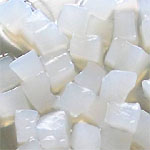
NATA DE COCO (coconut water) – Version 1
RAW MATERIALS
1 kg. fresh coconut, grated
325 mL or 1¼ cups glacial acetic acid
600 g or 3 cups refined sugar
500 ml or 2 cups coconut water
12 L tap water
2 L nata starter*
PROCEDURE
1. Mix grated coconut with water. Strain thru cheesecloth.
2. Add the rest of the ingredients and mix.
3. Pour the mixture into clean sterile fermenting basins or jars (2 inches depth). Set aside starter for use in 3-5 days.
4. Ferment for 12-14 days.
5. Harvest. Wash.
6. To cook it into a dessert:
– Cut nata into cubes or desired size.
– Boil in several changes of water until acidic taste or smell is completely removed.
– Cook in sugar at 1:1 ratio. If desired, add pineapple tidbits or nangka as flavorant.
NATA DE COCO (tap water) – Version 2
RAW MATERIALS
1 kg matured coconut, grated
400 ml glacial acetic acid
2 kg refined sugar
28 L tap water
5 L nata starter*
PROCEDURE
1. Mix grated coconut with tap water. Strain through cheesecloth.
2. Mix the rest of the ingredients.
3. Stir to dissolve the sugar.
4. Pour into clean, sterile fermenting basins or plastic trays. Cover with clean paper.
5. Ferment for 8-10 days.
6. Harvest, remove scum, wash and cut into cubes or desired size.
7. Boil in several changes of water until acidic taste/smell is completely removed.
8. Cook in sugar at a 1:1 ratio (1 kilo sugar to 1 kilo nata or 3/4 kilo sugar to 1 kilo nata). Boil until nata cubes become transparent.
* Pure culture is available at the Microbiology & Genetics Division, ITDI
Source: mis.dost.gov.ph




Hi:
I live in San Diego, California, USA. I am unable to find Acetobactor for production of Nata De Coco. can you kindly direct me to either a US supplier or any that you may know. thank you for your courtesy.
Hi. Can there be any other quick way to remove the acid in batches of nata de coco (ex. 1000 kilos) other than soaking it in flowing water for 2 days and boiling it in water continuously?
hey @blue777! I’m also a DLSU D student! Can you answer these questions (since you already checked your worksheets about 5 years ago LOL) I hope you still remember the answers… Jarring the growing nata is not allowed. Why? and What are the causes of failures in Nata manufacturing? HELP ME T_T
hello. its quite a long time that im interested to make nata not only it is bec. its a hit to my children but alos for business purposes. im wondering what is itdi (kahiya but im not updated with govt. officecs)im from isabela possible kayang makabili ako ng starter?
the dept of science and technology through the industrial technology devt institute (ITDI) has this technology. on d 2nd wk of july we are to conduct a seminar on nata de coco here in basud, camarines norte. camarines norte is also intensively planted wd coconut.
i’m from northern mindanao particularly bukidnon, i’m interested to learn how to grow nata de coco. any agency that you can recommend that conducts seminar or training re: this product? please do inform me coz’ i’m very much interested to take seminar for our livelihood program. and if possible send it at my email add; [email protected]. thank you very much. God bless!
dto kaya sa bataan, san pwede bumili ng starter… thanks…
If you have questions about Nata de Coco production, buying, and growing, don’t hesitate to contact us. We are a premier Kaong and Nata de Coco manufacturer in Mindanao, Philippines.
– Katrins Foods
Hi Katrins Foods, how do we contact you?
Hi, I am from India (Tamilnadu). I am interested in manufacturing nata de coco. I am looking for people who can assist me in manufacturing process and partnership.
With Regards,
Rajesh
0091 95009 53622
gd day, i wish to have a gd knwldge on nata de coco procedure as well as ingredients and all of the materials needed 4 procsing, i wish everyone would share for me thier knwldge on this matter.. ty ‘n god bless 2 those hu r kind hearted prsonalities……….
Hello,
I was wondering where I can buy the nata starter. I live in the Netherlands. I am very curious how it will taste -homemade-
Thanks!
Where can I find Nata de Coco in Australia? I live in and around Logan City in Queensland. Thanks.
hello manuel…actually po natutu po ako s auntie ko gumawa ng nata and now i want to start nata business d2 po s bicol.kaya lng po need ko po ng capital. my government institution po b n nag oofer ng financial assistance s mga katulad ko po? tnx a lot.God bless u
To Ambs;
“i live in bakersfield CA. where can we get nata starter or mother liquor?”
You can get in touch with Kombucha Manna tea growers they have the mother liquor.
Google Kombucha Manna Tea growers, you should be able to find one in your local area. I’m from NY and I found growers here.
The problem you will run into here in the US is the regulation of Acetic Acid. You need 99% strength. It is dispense only to license biologist, and companies that are license to produce products requiring this type of chemicals as their raw material.
I manage to purchase 90% before the homeland security law was in effect. It wasn’t restricted then. Using the mature Kombucha Tea starter I manage to grow the medium but it took much longer than average time and the quality was not good at all.
But keep educating yourself and you’ll hit the right mixture.
I’ve perfected this back in the 90’s in the Phils. and was marketing good volume to DOLE Phils. at wholesale price which in turn they export to Japanese Market. Japan is now importing their Nata from Indonesia. I stop my production when I move to US.
If you want it for consumption just buy the bottled Nata from Filipino stores. Saves you time and headache.
BTW. It’s high fiber and it’s a good compliment for weight loss formula. Too sweet for Diabetics though.
All the best to you.
JJ:>)
Would you be able to share your knowledge in nata de coco growing?
Thanks! My Email is [email protected]
this is my email [email protected] my # 09993105659
anybody can help me where i could learn making nata de coco, thanks
manuel galliguez
im very much interested in nata de coco making,,where i can buy nata starter here in sta rora laguna
Where can i avail that nata starter?
what is nata stater?
hello good pm po… i would just like to ask if anyone can help me regarding the bleeding of the colors of nata… what can be done during the sweetening to prevent the colors from bleeding out…. or what processing techniques that can help prevent it… thanks and more power!
although just joined now i was reading the previous threads…. at may makukulit talaga. matagal na ako di nakagawa ng nata de coco mga 10 years na, pero alam ko pa procedure at hanap din ako “nata starter/ mother liqour” . tanong lang kung may mga bagong update na ba ang DTI or ganoon pa rin… sa livelihood training nila ng ermats ko ako natuto gumawa e.
nata starter contains the bacteria Acetobacter Xylinum po which creates the nata film when sugar is provided in the mixture po… I guess you could make starter by inoculating Acetobacter xylinum in a sugary plus right amount of acid and coconut milk medium po… it is in the nata starter po that generates the film, if there is no nata starter, there would be no nata film at all… temperature and storage condition aside…
@Manuel
People don’t need to force me to make Nata de Coco, I’m making it by my own will. I’m making it because I want to. Even though I’m not from India, I am from South Asia and my job takes me all over the world; Philippines included. And yes, even though South Asia is rich with coconut, you still could not find any Nata de Coco in any supermarket. Believe me, I’ve tried.
But the way you effortless listed that “Nata starter” with no clue or any rhyme or reason as to what it really is (not even its proper chemical name) is what infuriated me. You listed that ingredient without a second thought, as if you expected everyone to know what that really is when really, most like myself haven’t even the slightest clue. However, I am now pleased to see that you have provided some information on this mysterious “Nata starter” though I admit some more is needed. I also apologize for my previous outburst, and hope that we have both come away from it by a little wiser.
@Anita
Sorry to confuse you but my post stated that “* Pure culture is available at the Microbiology & Genetics Division, ITDI”. The information came from our government and maybe you can blame them for not telling what a nata starter is or how to make one. I know It’s not my obligation to tell people how to formulate the nata starter because I’m just and entrepreneur and a blogger, not a scientist. I provided the info and provided the source so I hope you are contented with that.
what is the mother liqour, is it content of any yeast ?
Is it the same as nata starter ?
Hi Mr. Michael,
Can you post me a video of the Nata de coco making?
hello po!!! I just wanna ask for some help po… what is the effect of the sugar concentration of the nata yield po??? thanks po!!!
Hi Manuel,
Do you know what happen with the structure of nata de coco after cooking with sugar?? Why it become transparent??
I am very intersted at this!!!
Thanks!
Wow, I come here trying to look for ways to make Nata de Coco because you can’t find it in my country, and then what do I get for one of the ingredients? A freaking “Nata Starter”! Guess what genius, if I couldn’t find Nata de Coco in the first place, then what makes you think I’m gonna find something more complicated like the Nata starter – which sounds like a raw industrial material!? This recipe is an EPIC FAIL!
@Anita
No one is forcing you to make nata de coco. Nata starter is one special ingredient and if it’s easy to find, then no one will sell nata de coco because everybody can make it. Common sense isn’t it? BTW, I think you are from India right? (tracing IP). India is the third largest producer of coconut in the world and Indonesia is also producing nata de coco. ( see here http://www.bi.go.id/sipuk/en/?id=4&no=52301&idrb=46501 ) So I think India has nata de coco producer also. But if I’m wrong you can buy the nata starter in Microbiology & Genetics Division, ITDI (www.itdibiz.com)
@ethel: buying containers are pretty much expensive nowadays even if you go for wholesale, and it’s kinda hard to look for suppliers for these.. we use plastic trays which have RECTANGULAR base so as to be piled up on to each other to save space.. don’t worry, the arrangement of the trays doesn’t have much to do with the growth of nata – we even use to pile them up to 4-5 feet high^_^. just make sure you have the right room environment and the right room’s temperature to be able for the nata to properly grow.
I’m just starting to grow nata and my biggest concern is the design of the shelves that would maximize the number of containers it can hold without risking the growth of the nata, and where can i buy uniform containers to grow the nata in? I need about 500pcs containers. Tnx God bless…
@mcyshogun: tnx for that very well said answer. you hav just been proven that your family produce CLASS A nata de coco.I think those answers are all based from expirience, right?. ^^tnx for ur response…really apreaciated.
@angevil: yes, we’re from the same school, haha. Right. We bear the same question, same activity guess.. ^^ what did your proffessor say? those questions are posted 4 months ago..
hey blue777, the main factor why Nata de Coco is hard is because of its ACID content.. nata would not soften if you just fully penetrate it in syrup… DEACIDIFICATION is required to soften it (a process which involves some sort of complex gradual stirring of the product to remove the acid contents).. furthermore, deacidification process removes the sour taste from the nata de coco itself, afterwhich will be the sweetening process which in turn, at the same time, replaces the sour taste.. these two processes are ways of producing export quality nata de coco, which tastes the best of all..bla bla bla…
for simpler ways, based on experience, the longer nata de coco(make sure it is boiled for several counts…with sugar) stays in the fridge, the softer it gets… (–,) hehehe!!!
We are produce nata de coco since 1995 in west java, indonesia. If you interest to buy nata de coco with best quality, best service and competitive price, please contact us, Mr. Rana. Phone office : 62-21-91270222, fax : 62-21-46803018, email : [email protected]
hey blue777, are u studying at DLSU D we bear the same wuestions!!! activity in bio lab!! jeezzzz
Is there anybody here knows why is nata hard when not fully penetrated with syrup? Why “Jarring” the nata is not allowed? and what are the causes of failures in Nata manufacturing? I hope you guys know the answer. Please help me (T-T)…
i dont undertsand why does it hard to find a nata starter.what is the exact chemical name of nata starter.how does they made that kind of chemicals.
My family produce CLASS A nata de coco here in southern mindanao. We used to make them since 1994 and ineexport for japan. Kung gusto nyo po bumili or if you would like to make orders just contact +639298274303 for infos.. thank you. ^_^
Where can I get or buy the starter? I live in Binan, Laguna.
we sell :raw nata de coco (P16.00/kilo cube)
nata de coco starter (P500.00/1 liter)
acid (1 car bouy P2500.00)
for more info:
[email protected]
cel#09359326119
or visit us:
zone 6, bugo,cagayan de oro city
sino po pwede makapag benta at mag ship sa akin ng mother liqour ng nata de coco… im from south cotabato. thanks
i live in bakersfield CA. where can we get nata starter or mother liquor?
@Ambs
Don’t know where you can find nata starter in CA. Maybe you ca import it from here but not sure if it will need special permit.
saan ba pwede makaavail ng training for nata growing? or kahit na notes/guides man lng for nata growing..salamat
i’m from mindanao, email nyo lng po ako…tnx
Hello and thanks for your program,i just would like how to make personalized candles and how to grow mushrooms.
4617211
*nmin yn
gnda website nyo
A quick treat of Nata de Coco is to mix it with a can of evaporated milk and crushed ice. Try it!
This tip is from Katrins Foods
Producer of Quality Bottled Sweet Kaong and Nata de Coco
do you know that nata de coco are formed by lactic acid bacterial species Acetobacter aceti Sp xylene
i live jackonville. do they sell acetic acid and mother liquor in oriental stores. if not, can i order from you? i want to make for family only.us
pag sure oi…. wanted to buy nata de coco just contact me at:
[email protected]
or txt:09057852547
@augustine olan
Sino You? hindi ko maintindihan you.